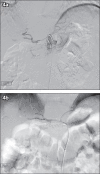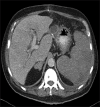Clinics in diagnostic imaging (176). Acute embolic occlusion of the coeliac artery
- PMID: 28429033
- PMCID: PMC5392602
- DOI: 10.11622/smedj.2017028
Clinics in diagnostic imaging (176). Acute embolic occlusion of the coeliac artery
Abstract
A 52-year-old man, who had a background of chronic heart disease and atrial fibrillation, as well as non-compliance with warfarin therapy, presented with a two-week history of worsening upper abdominal pain. Computed tomography mesenteric angiography showed complete embolic occlusion of the coeliac artery with resultant segmental splenic infarction, and thrombus within the left ventricle. A decision was made to proceed with catheter-directed thrombolysis. Subsequent follow-up angiogram at 12 hours showed successful treatment with complete dissolution of the coeliac embolus. The patient's symptoms resolved during his hospitalisation and he was subsequently discharged well on long-term oral anticoagulation therapy. Isolated acute embolic occlusion of the coeliac axis is a rare occurrence that may result in end-organ infarction. Treatment options include systemic anti-coagulation, mechanical thrombectomy, catheter thrombolysis or open surgery. Catheter-directed thrombolysis therapy is a feasible and effective option for treating acute thromboembolic occlusion of the coeliac artery.
Keywords: atrial fibrillation; catheter-directed thrombolysis; coeliac artery occlusion; embolus.
Copyright: © Singapore Medical Association.
Figures







References
-
- Tanaka Y, Nakajima M, Hirano T, Uchino M. Cardioembolic stroke followed by isolated celiac artery thromboembolism. Intern Med. 2007;46:1463–6. - PubMed
-
- Arul GS, Dolan G, Rance CH, Singh SJ, Sommers J. Coeliac axis thrombosis associated with the combined oral contraceptive pill: a rare cause of an acute abdomen. Pediatr Surg Int. 1998;13:285–7. - PubMed
-
- Farma JM, Hoffman JP. Nonneoplastic celiac axis occlusion in patients undergoing pancreaticoduodenectomy. Am J Surg. 2007;193:341–4. discussion 344. - PubMed
-
- O’Keefe JH, Jr, Holmes DR, Jr, Schaff HV, Sheedy PF, 2nd, Edwards WD. Thromboembolic splenic infarction. Mayo Clin Proc. 1986;61:967–72. - PubMed
Publication types
MeSH terms
Substances
LinkOut - more resources
Full Text Sources
Other Literature Sources

